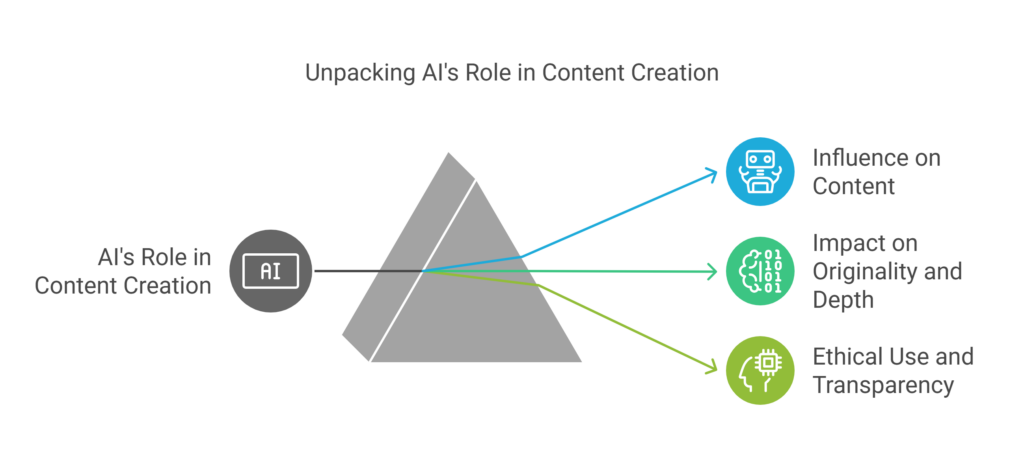Artificial Intelligence (AI) has become a transformative force in content creation, reshaping how we approach tasks such as research, writing, and editing. This new frontier offers exciting opportunities to enhance efficiency and creativity, yet it also introduces challenges that require thoughtful navigation. As AI tools gain prominence, transparency, and ethical usage must guide their integration into content workflows. To address this, the Computer Aided Content Creation (CACC) framework provides a structured system to evaluate and communicate the role of AI in content production.

Unpacking AI’s Role in Content Creation: Exploring its influence on content, impact on originality and depth, and the importance of ethical use and transparency.
The Evolving Role of AI in Content Creation
The integration of AI into content workflows reflects a broader trend of technological augmentation in creative industries. AI tools are employed for various tasks, from automating repetitive processes to generating sophisticated text or visuals. However, this increasing reliance on AI raises critical questions:
- How much of the content is influenced or created by AI?
- What impact does AI have on the originality and depth of the content?
- How can we ensure ethical use and transparency in this rapidly evolving landscape?
To address these questions, a clear, standardized approach is essential to evaluate the extent of AI involvement in content creation.
The CACC Framework: A Transparent Evaluation Scale
The Computer Aided Content Creation (CACC) framework is designed to assess and communicate the degree of AI involvement in content generation. This evaluation scale provides clarity and fosters trust among creators, audiences, and stakeholders.
CACC Scale: Levels of AI Involvement
0 – No AI Use:
- Content entirely created manually.
- No machine assistance.
- Reflects purely human-driven creativity.
1 – Minimal AI Support:
- AI used for basic tasks, such as spell-checking or formatting.
- Creative process remains entirely human-led.
2 – Light AI Assistance:
- AI employed for secondary tasks like research or data visualization.
- Human retains full creative control.
3 – Moderate AI Involvement:
- AI contributes to multiple tasks, including research, structuring, and simple text generation.
- Human oversight ensures alignment with creative goals.
4 – High AI Contribution:
- AI generates most of the content.
- Human plays a curatorial and editorial role.
- Creative input is influenced significantly by AI.
5 – Fully AI-Generated
- AI handles the entire creation process, including ideation, structuring, and text generation.
- Minimal human intervention limited to final review or approval.

The CACC Framework: A clear and structured scale to evaluate AI involvement in content creation, promoting transparency and trust among creators and audiences.
Balancing Creativity and Efficiency
While AI tools bring unparalleled efficiency, they must complement rather than replace human creativity. By clearly defining the extent of AI’s involvement, the CACC framework ensures:
- Transparency: Readers and stakeholders understand the role AI played in content creation.
- Ethical Standards: The framework promotes responsible use of AI, ensuring content remains authentic and free from unintended biases.
- Innovation: By leveraging AI for repetitive or technical tasks, creators can focus on higher-value aspects of the creative process.
Implementing the CACC Framework
1. Establishing Transparency
- Clearly disclose the AI tools used in content creation.
- Provide a detailed explanation of how AI contributed to the process.
2. Fostering Responsible Usage
- Develop industry-wide guidelines for ethical AI deployment.
- Encourage creators to evaluate the appropriateness of AI tools for their projects.
3. Encouraging Collaboration
- Promote a symbiotic relationship between human ingenuity and AI capabilities.
- Train creators to use AI as a tool rather than a replacement.
An Academic and Industry Perspective
Ethical and transparent use of AI in content creation is not only a technological challenge but also a societal one. Academic research highlights the importance of:
- Documenting Processes: Establishing traceable methodologies to showcase AI’s role in content creation.
- Preventing Manipulation: Ensuring AI-generated content aligns with ethical standards and avoids deceptive practices.
- Evaluating Outcomes: Developing robust frameworks to assess the impact of AI-assisted content on audiences.
Conclusion
The CACC framework offers a comprehensive approach to integrating AI into content creation responsibly. By defining and communicating the role of AI at every stage, creators can maintain transparency, foster trust, and harness the potential of this technology without compromising authenticity.
We invite you to engage in this important dialogue: How do you see AI shaping the future of content creation? How can we ensure a balance between technological efficiency and human creativity? Let’s explore these questions together and shape a thoughtful approach to the future of AI-assisted content.
Disclaimer
AI Tool Disclosure: Transparent Content Creation
In crafting this article, I utilized various AI tools to enhance efficiency and support the creative process. My primary focus remained maintaining full editorial responsibility and creative control.
Tools Utilized
- Illustrations: Napkin AI
- Outline & Proofreading: ChatGPT
- Research Support: Perplexity
These tools served to optimize and complement my work, never replacing human creativity and editorial oversight.
CACC Scale Evaluation
Rating: 3 – Moderate AI UsageRationale: AI supported peripheral tasks such as research, illustration generation, and proofreading. These activities increase efficiency while preserving the core creative process of ideation and elaboration. Structuring and substantive content development remained entirely under my creative control, with AI tools functioning purely as supportive instruments.
Why I Share My Insights: A Transparent Approach to Knowledge
I am committed to sharing meaningful perspectives without any sales agenda. My articles are not designed to sell services, training, or products, but to provide valuable insights freely. Writing allows me to articulate my thoughts and place them in a broader context, offering a creative counterbalance to daily professional routines. I do not claim to possess ultimate truth, but am genuinely interested in dialogue and learning from different perspectives. I welcome any feedback and invite you to engage in a constructive exchange of ideas.
